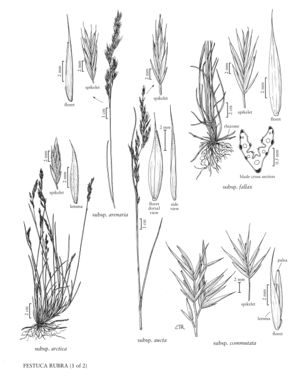Festuca rubra subsp. commutata
Plants without rhizomes, usually densely cespitose. Culms 25-90 cm. Sheaths redbrown, scarious near the base, puberulent or pubescent, slowly shredding into fibers; blades 0.3-0.7 (1) in diameter, conduplicate, sometimes glaucous, abaxial surfaces scabrous or smooth; abaxial sclerenchyma in narrow to broad strands; adaxial sclerenchyma rarely present. Inflorescences 4-13 (30) cm, more or less contracted, often secund; branches spreading at anthesis, scabrous on the angles. Spikelets 7-11 mm, with 3-9 florets. Glumes ovatelanceolate, acute; lower glumes 2.5-4 mm; upper glumes 3.5-5 mm; lemmas 4.5-6 mm, green or reddish violet distally, glabrous, smooth, awned, awns 1-3.3 mm; anthers 1.8-2.2 (3) mm. 2n = 28, 42.
Discussion
Festuca rubra subsp. commutata is extensively used for lawns and road verges. It is native to Europe, growing from southern Sweden southward, but is widely introduced elsewhere in the world. In the Flora region, it is common south of Alaska, Yukon Territory, and the Northwest Territories.
Selected References
None.
Lower Taxa
"wider than long" is not a number."decumbent" is not a number."longest" is not a number.
